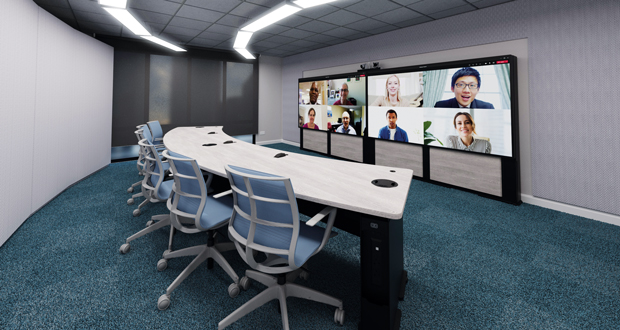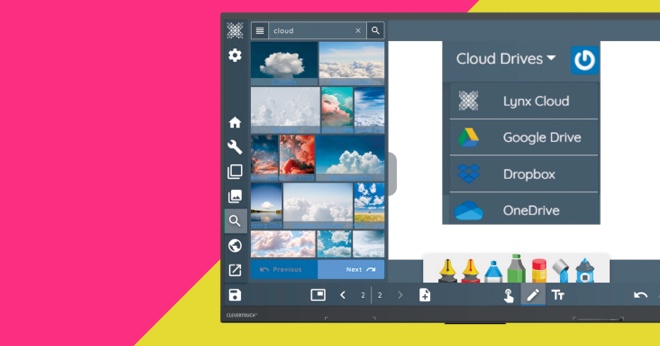Once reserved for the privileged few (or underprivileged few, depending on how much of a devil it was to use), video conferencing has been revolutionised by the global shift to remote and hybrid working during the last two years.
“The whole industry changed overnight, from a meeting room model of VC with a minority of remote users, to a one hundred per cent individual experience,” says Roger McArdell, CTO at Ashton Bentley Collaboration Spaces. “A few years ago, Cisco and Polycom dominated the market with hardware-based products tied to a corporate network backed by expensive infrastructure. Today, thanks to Covid, everything is cloud based. Anyone can talk to anyone else, cost of entry for any user is a pittance, and if you have Office 365 the tools are there to use already.”
Diversity and choice have become the watchwords. “I think a clearer market picture is emerging now,” says Jeff May, UK sales director at Konftel. “There’s a distinct investment choice between dedicated in-room solutions such as Teams or Zoom, and what we call ‘bring your own meeting’, where users bring their own equipment to a meeting room and choose the app of their choice. Organisations can choose either option, or even a mix of both.”
Creating a custom conferencing environment using a blend of off-the-shelf hardware has become easier and more affordable, according to Louis Bell-Proctor, technical account manager at Pure Audio Visual. “Certified hardware ensures compatibility with a native room system (eg. Microsoft Teams Rooms), and the majority of USB peripherals on the market (cameras, microphones) are consistently tested to plug and play with any conferencing application running on a PC. BYOD solutions from companies such as Barco ClickShare, Mersive and ScreenBeam are becoming more advanced and cross-compatible by the day, working seamlessly with hundreds of devices once connected.”
As homeworkers have become an influential market in their own right, a ‘prosumer’ segment has arisen to satisfy them. “We’ve introduced a line of personal video products designed and priced for home use,” says Sof Socratous, vice-president for northern Europe at Poly. “These target a wide range of homeworkers, from executives with a dedicated working space to interns living in shared accommodation.”
New features include ways to mitigate the kind of audio and video distractions that can plague those who are working from home, including privacy shutters, virtual backgrounds, acoustic fence technology, and AI for smart framing.
In the office, too, simpler, plug-and-play devices such as video bars and loudspeaker bars are taking some of the hassle – and expense – out of conferencing. “Video bars meet the needs of flexible meeting rooms that require super simple AV equipment,” says Socratous. “Users just plug their laptop into the USB cable and start a meeting using their VC platform of choice. The product range has expanded to cover all room sizes, with each requiring microphone and video clarity over greater distances. These solutions are significantly less expensive and less complicated to install than the traditional room AV system with suspended ceiling microphones and cameras installed by professional integrators.”
_main_xl_col10_hpad0(1).jpeg)
Mass uptake of video conferencing
Mass uptake has changed users’ expectations of VC significantly. “Since every level of employee is now using some form of video conferencing, every piece of technology in a collaboration system needs to be cost-effective, user friendly and easy to control or manage, in addition to offering high quality and performance,” says Nicole Corbin, senior director of Utelogy. “Not everyone is a technical expert, so whether it’s a camera, mic or display, it needs to work well without much user intervention.”
“The recent increase in demand, with a complete new set of requirements, has forced the channel to listen to the needs of the users themselves,” says Mark Tildesley, enterprise sales director at Clevertouch. “The old VC systems, with complicated, standalone codecs and specialist equipment and software, have very quickly become obsolete, and we’re now delivering integrated solutions that work how the user wants them to work.”
“Single, integrated products that incorporate audio, video, room control, USB switching and integration with UC technologies, such as Cisco Webex Room devices, have become the expectation of customers,” adds Gergely Vida, CEO of Lightware Visual Engineering.
“Users can expect to see more products that enable better visibility and control of devices, with software that enables multiple devices to be managed remotely,” says James Spencer, video solutions director at Jabra. “Video solutions can now be controlled seamlessly from one place via a dashboard with realtime analytics, thanks to a video bar with a 180-degree field of view that covers the whole room and feeds realtime information into the dashboard. The room can automatically be made available to book in the event of a no-show, and rooms can also be automatically booked simply by walking in.
“We’re also seeing hardware solutions that have intelligent, AI-driven features that make meetings feel more natural and lifelike, as if participants are in the same room – for example, VC cameras that enable whiteboard content to be shared in real time so that everyone can see and participate.”
The mass uptake of video conferencing has caused a notable increase in the development of new product features compared with pre-pandemic levels, according to Mark Kempson, AV design team manager at Kinly. “In the near future, we expect to be seeing a similar experience to mobile phones or smart TVs, where new VC features are available with regular updates.”

Dedicated support services
Another effect has been manufacturers expanding their support for organisations that do not have in-house IT or VC/UC knowledge and capability, according to Bell-Proctor. “They’re reducing the amount of time and resources required to successfully coordinate, install and maintain conferencing solutions, whether in one or two rooms or across multiple sites. Logitech’s JumpStart and Select programmes, for example, now provide dedicated deployment, management and monitoring services.”
The rapid expansion in remote working has introduced a new term into the lexicon: meeting equity. “This is the idea that everyone has an equal seat at the table, no matter where they are,” explains Lauren Simmen, director of product marketing at Crestron.
“That’s fairly easy to achieve when everyone’s remote, but if some people are gathered around a conference table you get a ‘bowling alley’ effect. Some are close to the camera, some aren’t. People having a natural conversation in the room turn and look at the person they’re speaking to. The person joining remotely isn’t always going to get the best angle. They’re going to see the backs of others’ heads, the sides of their faces. Perhaps the audio is muffled as someone turns away from the soundbar. This has driven the need for intelligent video solutions: cameras and software that can focus in on individual speakers, and ‘cut’ from one participant to another.
“These AI solutions demand multiple cameras, multiple screens and multiple mics with the proper arrays and coverage areas. If I’m attending a meeting on-site, I still need to have the remote attendees in my peripheral vision. Collaborations are dynamic, they’re not presentations. The hardware and software solutions we’re creating must address those issues.”
“With the continuing development of AI and the trend for solutions that create a real sense of in-person ‘togetherness’ for virtual participants, immersive audio will become more and more prominent in the coming years,” adds David Missall, insights manager at Sennheiser. “Immersive audio offers a more natural way of interacting that mimics the way people hear sounds in real life, so products that support and facilitate immersive or spatial audio will continue to be adopted.”
With mass-market VC becoming all the rage, where does this leave the high-end VC and telepresence solutions that were once the flagships of the industry? On this the jury is still out.
“I think the concept of high-end or ‘professional’ VC systems is history and was buried after the pandemic took hold,” says Zee Hakimoglu, president and CEO of ClearOne. “They’ve been replaced by cloud-based solutions that are easier to use, and have comparable if not higher quality results when matched with the right audio and camera devices based on the size of the space, whether at the desk or in a large meeting room.”
“We’ve seen a big increase in requests for Teams Rooms systems with dual, large-format displays to replace legacy three-screen Cisco and Polycom systems,” says McArdell. “These ‘executive’ rooms can now be done at a fraction of the cost, and as providers, such as Microsoft Teams improve the experience for the user we can supply very similar experiences. We’ve shifted from super quality for the few to good quality for all.”
But others believe that high-end systems also retain a role. “The challenge with many participants in one room brings technical expectations towards more professional solutions,” says Vida. “Remote management of dozens or hundreds of meeting rooms, up-to-date software and firmware upgrades, IT security in the enterprise, differentiating the person speaking from other participants in audio and video, multi-screen displays, are all requirements that a simple tablet can’t fulfil. Broad availability of VC systems catalyses the high-end solutions instead of making them obsolete.”
This article was originally published by AV Magazine, available here.

